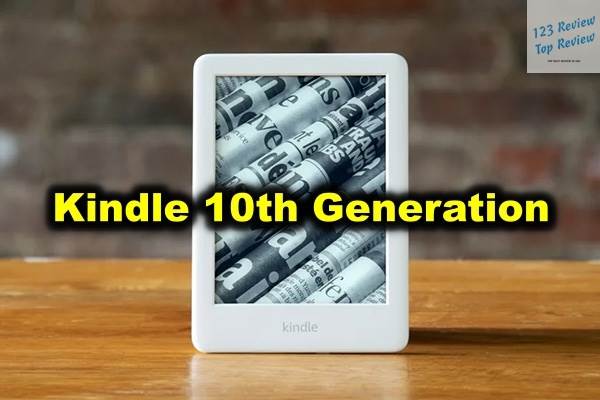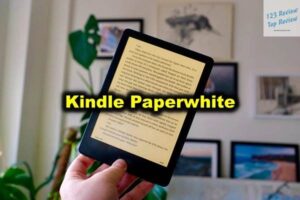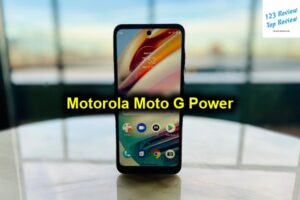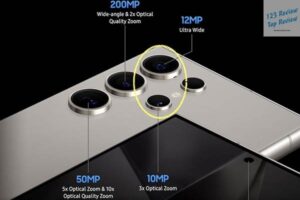Whether you’re a casual reader or someone who enjoys diving deep into books for hours on end, this Kindle 10th Generation model offers a blend of functionality, durability, and value.
In this comprehensive review, 123 Review will explore every aspect of the Kindle 10th Generation—from its key features to user experience, pricing, and customer feedback—to help you determine if this is the right device for your reading needs.
Key Features
Display and Resolution
At the heart of any e-reader is its display, and the Kindle 10th Generation doesn’t disappoint in this regard. The device features a 6-inch glare-free display that uses E Ink technology to mimic the appearance of real paper. This technology not only reduces eye strain but also makes it possible to read comfortably even in bright sunlight, a feature that many LCD tablets struggle with.

The display offers a resolution of 167 PPI (pixels per inch). While this is lower than the 300 PPI found in more premium Kindle models like the Paperwhite or Oasis, it is still sufficient for clear and crisp text. The difference in resolution might be noticeable if you’re reading very small text or if you’ve used a higher-resolution device before. However, for the majority of users, the Kindle 10th Generation provides an excellent reading experience that closely resembles reading a physical book.
One of the most significant upgrades in this model is the addition of a front light. Unlike earlier basic Kindle models that required external lighting for nighttime reading, the Kindle 10th Generation comes equipped with four LEDs embedded around the screen’s edge. These LEDs provide adjustable lighting that allows you to read comfortably in various environments, from bright outdoor spaces to dimly lit rooms. The light is evenly distributed across the screen, ensuring that you can read without any harsh glare or uneven lighting.
Storage Options
When it comes to storage, the Kindle 10th Generation offers 8GB of internal memory. This may not sound like much compared to modern smartphones or tablets, but for an e-reader, it’s more than enough. To put it in perspective, 8GB can store thousands of eBooks, depending on the file size. For instance, a typical novel in ePub or MOBI format is usually less than 1MB, meaning you could potentially carry an entire library in your pocket.
It’s important to note that the Kindle 10th Generation lacks the 32GB storage option available in higher-end models like the Kindle Paperwhite or Oasis. This limitation may be a consideration for users who plan to store a large number of audiobooks, comics, or PDFs, which can take up significantly more space. However, for those who primarily read text-based eBooks, 8GB should be more than sufficient.
The device also integrates seamlessly with Amazon’s cloud storage. Any book you purchase from the Kindle Store is automatically stored in the cloud, meaning you can re-download it at any time if you need to free up space on your device. This feature adds a layer of convenience, as you don’t have to worry about running out of storage or manually backing up your books.
Battery Life and Charging
Battery life is one of the Kindle’s strongest selling points, and the 10th Generation model lives up to the reputation. Amazon advertises that the device can last up to four weeks on a single charge, assuming you read for about 30 minutes per day with wireless off and the light setting at 13. In real-world use, this translates to roughly 20 hours of reading time, which is impressive for such a compact device.
The Kindle 10th Generation uses a micro-USB port for charging, which is a bit dated by today’s standards where USB-C has become the norm. Charging from 0% to 100% takes around four hours, which is relatively slow compared to modern devices. While this might be a drawback for some, it’s worth noting that the long battery life means you won’t need to charge it frequently. For most users, the device will only need to be plugged in once every few weeks.
One area where the Kindle 10th Generation could improve is the inclusion of fast charging or a more modern charging port. However, given the price point and the overall longevity of the battery, this is a minor inconvenience rather than a significant flaw.
Build Quality and Durability
The Kindle 10th Generation is built with practicality in mind. The device has a plastic body that feels both lightweight and durable, making it easy to carry around without worrying about damage. Weighing in at just 174 grams, it’s one of the lightest e-readers on the market, which is especially beneficial for readers who enjoy long sessions without the fatigue that can come from holding heavier devices.
Despite its lightweight design, the Kindle 10th Generation is surprisingly robust. The plastic casing is resistant to scratches and scuffs, and it can withstand minor drops and bumps that might occur during everyday use. However, unlike the Kindle Paperwhite and Oasis, the 10th Generation is not waterproof. This means it’s less suitable for reading by the pool, in the bath, or in other environments where water exposure is a risk.
The device’s design is minimalist, with a small Amazon logo on the back and a simple, unobtrusive front. The bezels around the display are reasonably thick, giving you a good grip area without accidentally touching the screen. Some users might prefer thinner bezels for a more modern look, but the current design ensures durability and ease of use.
Comparison with Other Kindle Models
Kindle vs. Kindle Paperwhite
When deciding between the Kindle 10th Generation and the Kindle Paperwhite, several factors come into play, primarily focusing on display quality, storage capacity, and additional features.
The most notable difference between the two is the display. The Kindle Paperwhite offers a 6-inch display with a resolution of 300 PPI, significantly sharper than the 167 PPI found on the Kindle 10th Generation. This higher resolution makes text appear crisper, which can be especially noticeable when reading smaller fonts or detailed graphics. Additionally, the Paperwhite has a flush-front design with a screen that sits level with the bezels, giving it a sleeker, more modern appearance.
Storage capacity is another key difference. While both the Kindle 10th Generation and the Paperwhite come with an 8GB option, the Paperwhite also offers a 32GB version. This makes the Paperwhite a better choice for users who plan to store a large number of books, particularly audiobooks and comics, which require more space.
One of the standout features of the Paperwhite is its water resistance. With an IPX8 rating, the Paperwhite can withstand immersion in up to two meters of fresh water for up to 60 minutes, making it ideal for reading by the pool, in the bath, or on the beach. In contrast, the Kindle 10th Generation does not offer any water resistance, limiting its versatility in environments where moisture is a concern.
Despite these differences, the Kindle 10th Generation has its own advantages. It’s more affordable, lighter, and offers the essential reading features that most users need. If you’re primarily looking for a budget-friendly e-reader and don’t require the advanced features of the Paperwhite, the Kindle 10th Generation is a compelling option.
Storage Capacity Differences
When it comes to e-readers, storage capacity can be a critical factor, especially for those who enjoy carrying a large library of books with them. The Kindle 10th Generation comes with 8GB of internal storage, which is sufficient for most users. To put it into perspective, an 8GB Kindle can hold thousands of eBooks, depending on the size of each file.
For those who enjoy listening to audiobooks via Audible, the 8GB storage might fill up more quickly, as audiobooks tend to be much larger in size compared to text-based eBooks. However, Amazon’s cloud storage feature alleviates some of these concerns by allowing users to delete and re-download purchased books as needed.
In contrast, the Kindle Paperwhite and Oasis offer a 32GB storage option. This extra capacity is particularly useful for users who want to store a vast collection of audiobooks, comics, or PDFs. The additional storage also provides more room for future purchases without worrying about space constraints.
While the 32GB option is a nice feature, it’s worth considering whether you truly need the extra space. For most users, especially those who primarily read novels or other text-heavy books, the 8GB offered by the Kindle 10th Generation is more than adequate. If you find yourself needing more storage, you can always manage your content through Amazon’s cloud storage, where all your purchased books are safely stored and can be accessed at any time.
Water Resistance Features
One of the most significant differences between the Kindle 10th Generation and the Paperwhite (or Oasis) is water resistance. The Kindle Paperwhite and Oasis both come with an IPX8 rating, meaning they can survive being submerged in up to two meters of fresh water for up to 60 minutes. This feature makes them ideal for users who want to read in the bath, by the pool, or on the beach without worrying about water damage.
Unfortunately, the Kindle 10th Generation does not offer any form of water resistance. This limitation means it’s less versatile in environments where exposure to water is a possibility. While this may not be a deal-breaker for everyone, it’s something to consider if you frequently find yourself reading in places where your device could get wet.
For users who prioritize a budget-friendly device and don’t need to read in wet environments, the lack of water resistance on the Kindle 10th Generation may not be an issue. However, if you’re looking for a more durable and versatile e-reader, especially for outdoor or water-prone environments, the Kindle Paperwhite or Oasis might be a better fit.
Pricing and Value for Money
One of the most appealing aspects of the Kindle 10th Generation is its affordability. Priced significantly lower than the Kindle Paperwhite and Oasis, the 10th Generation model offers excellent value for money. It provides all the essential features you need for reading eBooks, including a glare-free display, front lighting, and access to Amazon’s vast library of content.
While it lacks some of the premium features found in higher-end models—such as a higher-resolution display, water resistance, and more storage options—the Kindle 10th Generation is an excellent choice for budget-conscious readers. It’s perfect for those who want a reliable e-reader without breaking the bank.
Amazon often offers discounts and deals on its Kindle devices, especially during major shopping events like Black Friday, Prime Day, or back-to-school sales. These promotions can make the Kindle 10th Generation an even more attractive option, providing even greater value for money.
In terms of long-term value, the Kindle 10th Generation holds up well. Its durable design and long battery life mean that it’s likely to serve you well for years to come. Additionally, Amazon’s consistent updates to the Kindle software ensure that your device will continue to receive new features and improvements over time.
User Experience and Feedback
The Kindle 10th Generation has garnered positive reviews from users, particularly for its ease of use, portability, and affordability. Many users appreciate the simplicity of the device, noting that it does exactly what it’s designed to do: provide a comfortable and enjoyable reading experience.
One of the standout features for many users is the front-lit display. Readers who have upgraded from older Kindle models or other e-readers without built-in lighting often remark on how much easier it is to read in low-light conditions. The adjustable brightness is another frequently mentioned positive, as it allows users to tailor the lighting to their personal preference and reading environment.
In terms of build quality, users generally find the Kindle 10th Generation to be durable and lightweight. The plastic casing, while not as premium as the materials used in the Kindle Oasis, is robust enough to withstand everyday use. However, some users have mentioned that they would have preferred a waterproof design, especially those who like to read near water.
Battery life is another area where the Kindle 10th Generation excels. Many users report that they only need to charge the device every few weeks, which is a significant advantage for those who don’t want to be tethered to a charger.
While most feedback is positive, some users have noted the limitations of the 167 PPI display, particularly when compared to the higher resolution of the Kindle Paperwhite. If you’ve never used a higher-resolution e-reader, you might not notice the difference, but it’s something to keep in mind if you’re particular about screen quality.
Final Thoughts
The Kindle 10th Generation is a well-rounded e-reader that offers excellent value for money. It’s an ideal choice for casual readers, those new to e-readers, or anyone looking for a reliable device without the need for premium features. With its front-lit display, long battery life, and access to Amazon’s extensive library of eBooks, the Kindle 10th Generation delivers a satisfying reading experience at an affordable price.
While it may not have the high-resolution display, water resistance, or additional storage options found in the Kindle Paperwhite or Oasis, the Kindle 10th Generation covers all the basics most users need. Its lightweight design, ease of use, and affordability make it a standout option in the e-reader market.
Ultimately, the decision between the Kindle 10th Generation and other models like the Paperwhite or Oasis will come down to your specific needs and preferences. If you’re looking for a budget-friendly e-reader that doesn’t compromise on the essentials, the Kindle 10th Generation is an excellent choice that will serve you well for years to come.





